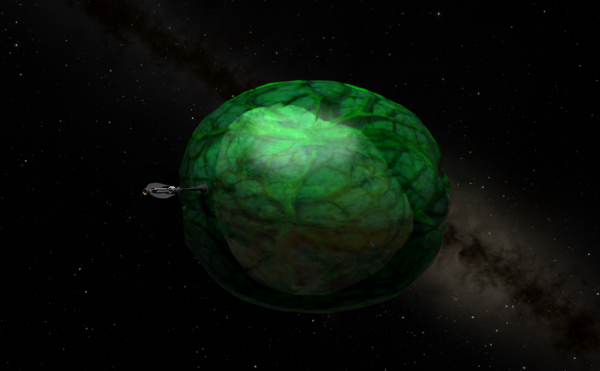BY LETTER
Yggdrasil Bush, Yggy
Technology > Application > Agriculture
Science > Biology > Botany
Technology > Technology Type or Material > Gengineering
Technology > Technology Levels > High Tech / Hitech
Technology > Application > Infrastructure
Technology > Application > Megascale Engineering
Technology > Technology Type or Material > Organic/Biotech
Science > Biology > Botany
Technology > Technology Type or Material > Gengineering
Technology > Technology Levels > High Tech / Hitech
Technology > Application > Infrastructure
Technology > Application > Megascale Engineering
Technology > Technology Type or Material > Organic/Biotech
Variant of the Orwood space tree | |
 Image from Steve Bowers | |
| This Yggdrasil Bush completely covers the asteroid it is growing on, and provides a habitable environment beneath its canopy; a visiting spacecraft can be seen docked to a pylon which extends beyond the outer skin | |
Yggdrasil bushes are biological space habitats, which combine the Orwood (Dyson Tree concept and the Greenbubble concept.
Designed to thrive in vacuum or minimal atmosphere conditions, Yggdrasil bushes (or Yggys as they called colloquially) may be planted on any suitable body with at least 1/100G surface gravity. During its growth phase, the Yggdrasil bush mines minerals, atmospheric gases, and water out of the soil and stores them within its trunk. Using a portion of the stored gases, it ejects a set of seed packets from itself once every few weeks. Each bush broadcasts its position using bioluminescent cells on its trunk and leaves. When a sufficient number of bushes have accumulated, their bio-luminescent signals naturally form a primitive local network. The direction and trajectories of future seed packets are determined using data shared by this network in order to maximize plant growth and area coverage for the forest as a whole.
 Image from Steve Bowers | |
| This immature Yggdrasil Bush only covers a fraction of the planetoid it is growing on; eventually the canopy will cover the entire object, and only then will the plant release atmospheric gases | |
In the final phase of their growth, the Yggdrasil bushes alter their biochemistry to maintain and support the newly created atmosphere. Symbiotic soil gardening organisms are budded off of the bush root systems and the other basic elements of a self-sustaining ecosystem are a rapidly budded off from the bushes as well. Starting from a single seed, a complex of Yggdrasil bushes can convert an entire dead world into a living habitat in as little as twenty years.
There are various possibilities with the use of this versatile neogenic plant. Options include designing support pillars to look like giant trees, or using a variant of the dyson tree to cover a moon or planetoid in a huge forest with the canopy merging together to hold in an atmosphere. Yggdrasil bushes can be easily seeded on small ice moons and halo objects. Aleph Michio Ee adapted the Bluesky worldhouse to be photosynthetic, making the Greensky worldhouse... These involve an adaptation of the Yggdrasil bush with enough atmosphere to fly a light aircraft about without hitting the tree trunks.
 Image from Steve Bowers | |
| A mature Yggdrasil bush covering an irregular double-lobed asteroid. Local gravity on asteroids of this kind may be unusual, and in certain cases there may be small regions of negative gravity (however this effect is extremely small) | |
One popular variant is a Fucus vesiculosus - Bladderwrack - modification that can develop in Gas Giant rings, with a small (100-200m) bladder full of breathable air, sometimes with edible fruit and nuts growing on the inside. The bladders are loosely connected, with insulated flexible corridors between the bladders, and all the ice and rock of the rings incorporated into the spaceweed to avoid collision damage.
Related Articles
Appears in Topics
Development Notes
Text by Todd Drashner and Steve Bowers
Initially published on 25 October 2007.
image by steve bowers added 2024
Initially published on 25 October 2007.
image by steve bowers added 2024






